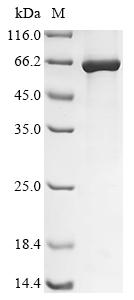Recombinant Human adenovirus C serotype 5 Early E1A protein
CAT:
399-CSB-EP355994HIL-03
Size:
20 µg
Price:
Ask
- Availability: 24/48H Stock Items & 2 to 6 Weeks non Stock Items.
- Dry Ice Shipment: No




Recombinant Human adenovirus C serotype 5 Early E1A protein
- CAS Number: 9000-83-3
- UniProt: P03255
- Expression Region: 1-289aa
- Organism: Human adenovirus C serotype 5 (HAdV-5) (Human adenovirus 5)
- Target Sequence: MRHIICHGGVITEEMAASLLDQLIEEVLADNLPPPSHFEPPTLHELYDLDVTAPEDPNEEAVSQIFPDSVMLAVQEGIDLLTFPPAPGSPEPPHLSRQPEQPEQRALGPVSMPNLVPEVIDLTCHEAGFPPSDDEDEEGEEFVLDYVEHPGHGCRSCHYHRRNTGDPDIMCSLCYMRTCGMFVYSPVSEPEPEPEPEPEPARPTRRPKMAPAILRRPTSPVSRECNSSTDSCDSGPSNTPPEIHPVVPLCPIKPVAVRVGGRRQAVECIEDLLNEPGQPLDLSCKRPRP
- Tag: N-terminal 6xHis-SUMO-tagged
- Source: E.coli
- Field of Research: Others
- Assay Type: In Stock Protein
- Relevance: Plays a role in viral genome replication by driving entry of quiescent cells into the cell cycle. Stimulation of progression from G1 to S phase allows the virus to efficiently use the cellular DNA replicating machinery to achieve viral genome replication. E1A protein has both transforming and trans-activating activities. Induces the disassembly of the E2F1 transcription factor from RB1 by direct competition for the same binding site on RB1, with subsequent transcriptional activation of E2F1-regulated S-phase genes and of the E2 region of the adenoviral genome. Release of E2F1 leads to the ARF-mediated inhibition of MDM2 and causes TP53/p53 to accumulate because it is not targeted for degradation by MDM2-mediated ubiquitination anymore. This increase in TP53, in turn, would arrest the cell proliferation and direct its death but this effect is counteracted by the viral protein E1B-55K. Inactivation of the ability of RB1 to arrest the cell cycle is critical for cellular transformation, uncontrolled cellular growth and proliferation induced by viral infection. Interaction with RBX1 and CUL1 inhibits ubiquitination of the proteins targeted by SCF (FBXW7) ubiquitin ligase complex, and may be linked to unregulated host cell proliferation. The tumorigenesis-restraining activity of E1A may be related to the disruption of the host CtBP-CtIP complex through the CtBP binding motif. Interaction with host TMEM173/STING impairs the ability of TMEM173/STING to sense cytosolic DNA and promote the production of type I interferon (IFN-alpha and IFN-beta). Promotes the sumoylation of host ZBED1/hDREF with SUMO1.
- Purity: Greater than 85% as determined by SDS-PAGE.
- Activity: Not Test
- Length: Full Length
- Form: Liquid or Lyophilized powder
- Buffer: If the delivery form is liquid, the default storage buffer is Tris/PBS-based buffer, 5%-50% glycerol. If the delivery form is lyophilized powder, the buffer before lyophilization is Tris/PBS-based buffer, 6% Trehalose, pH 8.0.
- Reconstitution: We recommend that this vial be briefly centrifuged prior to opening to bring the contents to the bottom. Please reconstitute protein in deionized sterile water to a concentration of 0.1-1.0 mg/mL.We recommend to add 5-50% of glycerol (final concentration) and aliquot for long-term storage at -20℃/-80℃. Our default final concentration of glycerol is 50%. Customers could use it as reference.
- Molecular Weight: 44.8 kDa
- References & Citations: "DNA tumor virus oncogenes antagonize the cGAS-STING DNA-sensing pathway." Lau L., Gray E.E., Brunette R.L., Stetson D.B. Science 350:568-571 (2015).
- Storage Conditions: The shelf life is related to many factors, storage state, buffer ingredients, storage temperature and the stability of the protein itself. Generally, the shelf life of liquid form is 6 months at -20℃/-80℃. The shelf life of lyophilized form is 12 months at -20℃/-80℃.
